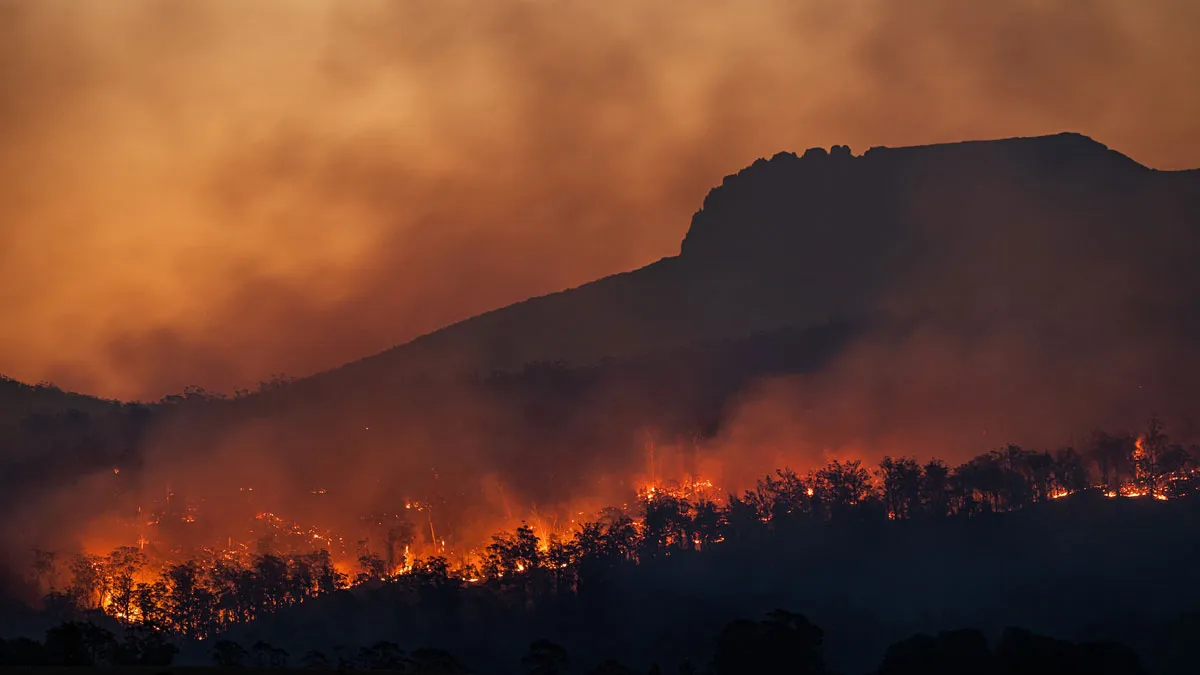Wildfire Smoke Destroys Ozone
Smoke aerosols from large wildfires are the perfect reaction surface for chlorine chemicals, speeding their transformation from ozone-friendly forms to reactive ones.
EOS: In the middle of the 20th century, humanity unleashed chlorofluorocarbons (CFCs) into the atmosphere. By the 1980s, CFCs had gnawed away at the planet’s ozone shield, endangering safety and health on Earth. Worldwide restrictions and bans have begun to heal the damage, but new results have suggested that increasingly severe wildfires could be stalling progress.
Liquid droplets containing wildfire smoke act like tiny reaction chambers for chlorine in the stratosphere, producing reactive forms of the element that degrade ozone over the midlatitudes, researchers reported in Nature.
“This is a completely new chemistry that we’re looking at.”
This chemical mechanism had “never been seen before,” said study coauthor and atmospheric scientist Kane Stone of the Massachusetts Institute of Technology. “This is a completely new chemistry that we’re looking at.”
Large wildfires are expected to happen more often as the planet warms, so the new finding has raised concerns that intensifying fires could stall the recovery of the stratospheric ozone layer, which protects Earth’s surface and its inhabitants from harmful ultraviolet (UV) radiation.
Banned Chemicals
Once widely used in aerosol sprays and refrigerants, CFCs are simple chemicals containing carbon, chlorine, and fluorine. When these chemicals rise to the stratosphere, UV light breaks them down, releasing the chlorine. Once loose in the atmosphere, a single chlorine atom can destroy more than 100,000 ozone molecules.
Chlorine atoms stop destroying ozone once they end up in a molecule of hydrochloric acid or chlorine nitrite. These two chemicals usually don’t react with ozone. But aerosol particles facilitate chemical reactions that transform these ozone-safe forms of chlorine into more reactive compounds. They do this by grabbing hydrochloric acid and chlorine nitrate out of the air and putting them in the proximity of other chemicals, which speeds up reactions. This transformation is a problem mostly in stratospheric clouds over the poles, which are full of liquid and ice aerosols that, when encountering hydrochloric acid and chlorine nitrate, contribute substantially to ozone degradation. Other aerosols, like volcanic ash, can also cause problems.
Following the disastrous 2020 wildfire season in Australia, “there were observations of really unusual chemistry occurring in the stratosphere,” Stone said, including record low levels of hydrochloric acid and a dip in ozone over the southern midlatitudes.
Stone and his colleagues thought wildfire smoke aerosols might explain the unusual observations. Over the midlatitudes, it’s usually too warm for hydrochloric acid and chlorine nitrate to glom onto water or ice aerosols, so they wouldn’t usually react to form ozone-degrading chemicals. But wildfire smoke is full of aerosolized carbon-based liquids such as alcohols and organic acids, which can absorb hydrochloric acid more readily than water does at warmer temperatures. By providing a reaction surface for chlorine chemicals, wildfire smoke could facilitate ozone degradation.
To see whether these organics were facilitating ozone depletion, the scientists dug up decades of old laboratory measurements—made mostly in the 1950s and 1960s—on the solubility of hydrochloric acid in various carbon-based liquids. They incorporated these data into a computer simulation of the atmosphere’s chemistry following the 2020 Australian fires and compared the results with the real measurements.
When it came to ozone depletion, “nobody really was thinking about wildfires and smoke.”
Accounting for the greater solubility of hydrochloric acid in organic liquids in their simulations produced “results that look really, really close to what we saw in the observations,” Stone said.
The finding suggested that smoke from the Australian fires depleted about 3%–5% of the ozone layer over the southern midlatitudes.
Only within the past 5–7 years have researchers started to recognize that strong plumes of wildfire smoke could reach the stratosphere at all, said lidar specialist Albert Ansmann of the Leibniz Institute for Tropospheric Research in Germany, who was not involved in the new study.
When it came to ozone depletion, “nobody really was thinking about wildfires and smoke,” he said.
Stalled Recovery?
CFCs have slowly disappeared since the United Nations unanimously chose to restrict them with the passage of the Montreal Protocol in 1987. The ozone layer is on track to return to its pre-1980s state by the mid-2060s in Antarctica, by 2045 in the Arctic, and by 2040 everywhere else.
But climate change could complicate that recovery, Stone and Ansmann said. In many fire-prone regions, such as boreal forests, climate change is expected to intensify the frequency and severity of fires.
And fires don’t deplete ozone over just the regions where they occur—smoke from distant fires can wreak even more havoc at the poles than at the midlatitudes, Ansmann pointed out. He and colleagues have linked large wildfires (and their synergy with polar stratospheric clouds) to ozone depletion of 10%–30% over Antarctica.
Scientists are still learning about how smoke behaves in the stratosphere and how it interacts with ozone. In the future, Stone said, it will be important to test how ozone recovery will respond as wildfires become more severe because of climate change. Updating old studies of how well chlorine chemicals dissolve in organic liquids will also be important, he added.
The perhaps unintuitive link between wildfires and ozone depletion shows that it’s hard to say what the future will bring as climate changes ripple through the web of feedback loops that govern the natural world.
—Elise Cutts (@elisecutts), Science Writer
Citation: Cutts, E. (2023), Wildfire smoke destroys ozone, Eos, 104, https://doi.org/10.1029/2023EO230148. Published on 12 April 2023.
Text ©2023. The authors. CC BY-NC-ND 3.0.
